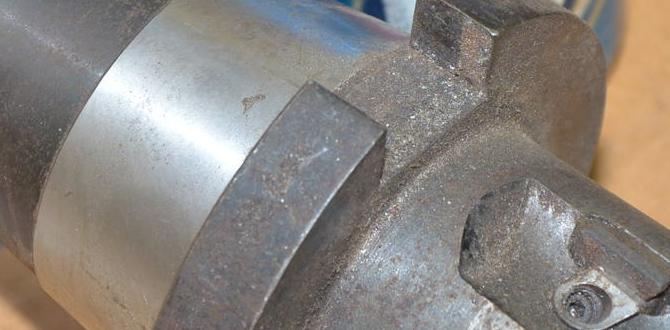Carbide End Mill 1/8 Inch for G10: Your Go-To for Clean Cuts and Precision. This guide explains how to use a 1/8 inch carbide end mill, especially with MQL, for successful G10 machining, ensuring accuracy and ease for beginners.
Working with G10 can be tricky. This super strong composite material is fantastic for things like knife handles and structural parts, but it can quickly wear down standard tools or create messy edges if you’re not careful. When you need to cut intricate shapes or make precise slots in G10, a small but mighty tool is your best friend: the 1/8 inch carbide end mill. Especially when you’re using a 1/8 inch shank standard length end mill with MQL (Minimum Quantity Lubrication), you can achieve amazing results. This article will guide you through exactly how to use this specific tool for perfect G10 success, making it simple even if you’re just starting out.
Why a 1/8 Inch Carbide End Mill is Perfect for G10
G10, a laminate of fiberglass cloth and epoxy resin, is known for its exceptional strength, electrical insulation properties, and resistance to heat and moisture. These same qualities make it challenging to machine. It’s abrasive, meaning softer tool materials will dull very quickly. This is where carbide shines. Carbide is significantly harder and more wear-resistant than high-speed steel (HSS), making it the ideal choice for G10.
The 1/8 inch size is particularly useful for several reasons:
- Detail Work: A smaller diameter allows for finer details, sharper corners, and the ability to cut narrow slots, which are often required in G10 projects.
- Maneuverability: It leaves a narrower kerf (the width of the cut), which means less material to remove and less stress on both the tool and the workpiece.
- Heat Management: Smaller diameter tools, when run properly, generate less heat overall compared to larger tools, which is beneficial when machining materials like G10 that can experience thermal expansion or softening.
Understanding Your 1/8 Inch Carbide End Mill
Not all 1/8 inch carbide end mills are created equal. For G10, you’ll want to look for specific features:
Key Features to Look For:
- Material: Ensure it’s solid carbide. While carbide-tipped end mills exist, solid carbide offers better performance and durability for this application.
- Number of Flutes: For G10, a 2-flute or 3-flute end mill is generally recommended.
- 2-Flute: Offers better chip clearance, which is crucial for materials like G10 that can produce stringy chips. It’s often faster and more efficient.
- 3-Flute: Provides a smoother finish and greater rigidity. It can handle slightly heavier cuts but with less chip clearance.
- Coating: While not strictly necessary for G10, coatings like TiAlN (Titanium Aluminum Nitride) or ZrN (Zirconium Nitride) can further enhance wear resistance, reduce friction, and improve performance, especially when running dry or with MQL.
- Helix Angle: A steeper helix angle (e.g., 30-45 degrees) generally provides a shearing action that cuts more effectively and produces better chip evacuation.
- End Type: Most common are flat end mills, used for slotting, profiling, and general milling. Ball end mills are used for creating curved surfaces or fillets. For most G10 work, a flat end mill is sufficient.
When we talk about a “1/8 inch shank standard length for G10 MQL friendly” carbide end mill, we’re looking for a tool that’s designed for these specific conditions. The 1/8 inch shank means the overall diameter of the tool shank is 1/8 inch, and its cutting diameter will also be 1/8 inch. “Standard length” typically refers to a general-purpose flute length and overall tool length. “MQL friendly” implies the tool geometry and material are suited for lubrication systems that use very small amounts of coolant.
For more detailed information on end mill types and their applications, you can often find helpful resources on the websites of major tooling manufacturers or educational sites like those from university engineering departments. For instance, a guide on end mill geometry might be found on an educational resource like Penn State University’s Engineering department, which often details cutting tool types and their mechanics.
The Importance of MQL (Minimum Quantity Lubrication) for G10
Machining G10 can generate significant heat due to its abrasive nature and the friction created. High temperatures can lead to:
- Reduced tool life: Carbide softens at high temperatures.
- Material degradation: G10 can soften, melt, or burn, leading to poor surface finish and dimensional inaccuracies.
- Chip welding: Chips can stick to the end mill, causing tool breakage or poor chip evacuation.
MQL systems deliver a fine mist of lubricant and air directly to the cutting zone. This provides several benefits when machining G10 with an end mill:
- Effective Cooling: The mist cools the cutting edge and the workpiece, preventing excessive heat buildup.
- Lubrication: The lubricant reduces friction between the tool and the material, leading to cleaner cuts and less tool wear.
- Chip Evacuation: The air component helps blow chips away from the cutting area, preventing re-cutting and improving chip flow.
- Reduced Mess: Compared to flood coolant, MQL uses a fraction of the fluid, making it cleaner, more environmentally friendly, and easier to manage in a home workshop.
When choosing an MQL-friendly end mill, look for designs that promote good chip flow and can withstand the higher cutting speeds and feeds often used with MQL. Solid carbide with appropriate coatings is excellent for this.
Essential Tools and Setup for G10 Machining
Before you start milling, gather everything you need for a successful and safe operation.
Tools and Equipment Checklist:
- CNC Mill or Router: Capable of holding the 1/8 inch end mill securely and providing precise control over speed and feed rates.
- 1/8 Inch Carbide End Mill: Specifically designed for composite materials if possible, or a general-purpose solid carbide end mill.
- MQL System: With appropriate coolant concentrate.
- Workholding: Clamps, a vise, or a vacuum table to firmly secure the G10 workpiece. Ensure your workholding doesn’t interfere with the tool path.
- Dust Collection: G10 dust can be irritating and harmful. A good vacuum system attached to your machine is crucial for both safety and keeping your workspace clean.
- Safety Glasses: Essential for eye protection against flying debris.
- Respirator/Dust Mask: To protect your lungs from fine G10 particulates.
- Measuring Tools: Calipers, ruler, or digital probe for setting dimensions and checking accuracy.
- Deburring Tool (Optional): For cleaning up any minor imperfections after milling.
Setting Up Your Machine:
- Secure the Workpiece: Mount the G10 firmly. Ensure there are no gaps or movement. For thin G10, consider using a spoilboard or clamping it to an even surface.
- Install the End Mill: Insert the 1/8 inch carbide end mill into your collet or tool holder. Ensure it’s seated properly and tightened securely according to your machine’s specifications.
- Connect MQL: Set up your MQL system, ensuring the nozzle is positioned to direct the mist precisely at the cutting edge of the tool.
- Set Zero Point: Carefully establish your X, Y, and Z zero points on the workpiece. This is critical for accurate milling.
- Set Spindle Speed: This is a crucial setting. For a 1/8 inch carbide end mill in G10, typical speeds might range from 10,000 to 24,000 RPM, depending on your machine and the end mill’s design. Start conservatively.
- Set Feed Rate: This is how fast the tool moves through the material. For a 1/8 inch end mill in G10 with MQL, feed rates might range from 10 to 30 inches per minute (IPM). Again, start conservatively.
Step-by-Step: Milling G10 with a 1/8 Inch Carbide End Mill
Let’s walk through the actual milling process. We’ll assume you’re doing some basic profiling or pocketing.
Step 1: Load Your G-Code or Create Toolpaths
Using your CAM software, create the toolpaths for your desired operation. Define the 1/8 inch end mill as your tool. Set your cutting depths, stepovers (the amount the tool moves sideways for each pass), and stepdowns (the amount the tool plunges or moves down per pass). For G10, deep single passes are generally not recommended. Multiple shallow passes are better for tool life and finish.
Step 2: Set Up MQL System
Turn on your MQL system. Adjust the flow of coolant and air to create a fine mist that lands directly on the cutting area. You don’t want a flood, just a consistent mist.
Step 3: Perform a “Dry Run” (Optional but Recommended)
Many CNC machines have a “dry run” or “air cutting” mode. This allows the machine to go through the motions of the program without the spindle spinning or the tool touching the material. Use this to check for any crashes, unexpected movements, or clearance issues.
Step 4: Initiate the Cut
Once everything is set, begin the machining process.
- Plunge Cut (if applicable): If your toolpath involves plunging into the material, do so slowly. A feed rate for plunging might be significantly slower than your cutting feed rate, perhaps 5-10 IPM.
- Engage Cutting Feed: Once at depth, the mill will move at your programmed cutting feed rate.
- Monitor Operations: Keep an eye and ear on the machine. Listen for any unusual sounds like chattering or grinding, which could indicate feed rate or speed issues, or a dull tool. Watch the chip formation – a good cut will produce small, well-formed chips.
Step 5: Depth of Cut and Stepover Strategy
For a 1/8 inch end mill in G10, a good starting point for stepdown (depth of each pass) is usually between 0.020″ and 0.060″. For stepover (width of each pass when profiling or pocketing), aim for 30-50% of the tool diameter. So, for a 1/8″ (0.125″) tool, a stepover of 0.040″ to 0.062″ is a good range.
Table 1: Recommended Cutting Parameters (Starting Points for 1/8″ Carbide End Mill in G10)
| Parameter | Typical Range | Notes |
|---|---|---|
| Spindle Speed (RPM) | 10,000 – 24,000 | Higher speeds if machine is rigid and MQL is effective. |
| Cutting Feed Rate (IPM) | 10 – 30 | Start lower and increase if the cut is clean. |
| Plunge Feed Rate (IPM) | 5 – 10 | Always much slower than cutting feed. |
| Stepdown (Depth per Pass) | 0.020″ – 0.060″ | Shallower passes are better for G10. |
| Stepover (Side-to-Side) | 0.040″ – 0.062″ (30-50% of 1/8″) | Affects surface finish and cut time. |
These are starting points. Always consult the end mill manufacturer’s recommendations if available. For broader machining best practices, resources like the Sandvik Coromant knowledge base offer valuable insights into machining parameters.
Step 6: Finishing Passes
For critical dimensions or a very smooth edge, consider using a final finishing pass. This pass typically uses a higher feed rate and a very shallow stepdown (e.g., 0.005″ – 0.010″) with a larger stepover (up to 80-90% of the tool diameter). This pass “burnishes” the edge rather than aggressively removing material.
Step 7: Complete the Job and Clean Up
Once the milling is complete, allow the spindle to stop before retracting the tool. Carefully remove the workpiece from the machine. Clean the G10 part to remove any dust or residue. Inspect your work for accuracy and finish. Clean your machine, especially the dust collection system and MQL nozzle.
Troubleshooting Common Issues
Even with the best precautions, you might run into problems. Here’s how to address them:
Issue: Rough Surface Finish
- Possible Causes: Worn tool, too high feed rate, too high depth of cut, poor chip evacuation, insufficient coolant.
- Solutions:
- Inspect the end mill for wear or chipping. Replace if necessary.
- Reduce the feed rate or depth of cut.
- Ensure MQL is properly directed and flowing.
- Check your toolpath for inefficient movement.
Issue: Tool Breakage
- Possible Causes: Feed rate too high, plunging too fast, excessive depth of cut, material inconsistency, workholding failure, tool chatter.
- Solutions:
- Slow down feed rate and plunge rate.
- Reduce depth of cut.
- Ensure workpiece is absolutely secure.
- Address any sources of vibration or chatter (e.g., loose machine components, incorrect spindle speed).
- Try a new, sharp end mill.
Issue: Melting or Burning G10
- Possible Causes: Insufficient cooling, too slow feed rate (causing tool to rub instead of cut), dull tool.
- Solutions:
- Increase MQL flow.
- Increase feed rate slightly, while ensuring chip load is appropriate.
- Use a sharp, new end mill.
Issue: G10 Dust Accumulation
- Possible Causes: Inadequate dust collection.
- Solutions:
- Ensure your dust collection system is properly connected and has good suction.
- Check for blockages in hoses or the vacuum unit.
- Consider a containment shroud around the cutting area if your system allows.
Safety First: Always
Machining G10, especially with fine dust, requires vigilance. Always adhere to safety protocols:
- Eye Protection: Safety glasses are non-negotiable.
- Respiratory Protection: A good respirator or dust mask is vital to prevent inhalation of G10 particulates.
- Secure Workholding: A loose workpiece is a major hazard.
- Machine Guarding: Keep machine guards in place.
- Know Your Machine: Understand emergency stop procedures.
- Tool Installation: Ensure end mills are properly installed in collets.
For more on safety in machining environments, the Occupational Safety and Health Administration (OSHA) provides comprehensive guidelines for machine guarding and safe operation.
FAQ: Your 1/8 Inch Carbide End Mill Questions Answered
Q1: Can I use a regular end mill for G10, or do I really need a carbide one?
While you can try with a high-speed steel (HSS) end mill, it will dull very, very quickly. G10 is abrasive, and HSS tools will wear out almost immediately, producing poor cuts. Carbide is the industry standard for machining composites like G10 because of its hardness and wear resistance. A carbide end mill will last much longer and






